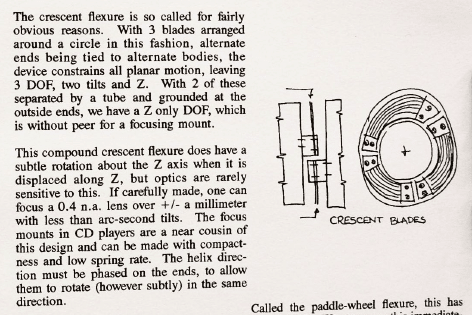I'm reading 'Precision Mechanics Notes' by David Kittell and on page number 14, the author talks about 'crescent flexure'. From the given description and the drawing, I'm not able to understand the construction and working of the described kinematics flexure. Can you describe the construction and working of this kinematic arrangement or share more resources (links/ books/ videos) especially for single DoF motion?
Navigation
Install the app
How to install the app on iOS
Follow along with the video below to see how to install our site as a web app on your home screen.
Note: This feature may not be available in some browsers.
More options
Style variation
-
Congratulations cowski on being selected by the Eng-Tips community for having the most helpful posts in the forums last week. Way to Go!
You are using an out of date browser. It may not display this or other websites correctly.
You should upgrade or use an alternative browser.
You should upgrade or use an alternative browser.
What is a crescent flexure (kinematic flexure in precision engineering)?
- Thread starter kbad
- Start date
- Status
- Not open for further replies.
Not sure what the issue is; there are two annular/round pieces with tabs that attach to the 3 crescents that are between them.

TTFN (ta ta for now)
I can do absolutely anything. I'm an expert! faq731-376 forum1529 Entire Forum list

TTFN (ta ta for now)
I can do absolutely anything. I'm an expert! faq731-376 forum1529 Entire Forum list
so "crescent flexure" is flexure of crescents ?
not sure what they mean by "grounded at the outside ends" as a way to react the two out-of-plane moments.
so this cunning design is essentially a single degree of freedom spring ?
another day in paradise, or is paradise one day closer ?
not sure what they mean by "grounded at the outside ends" as a way to react the two out-of-plane moments.
so this cunning design is essentially a single degree of freedom spring ?
another day in paradise, or is paradise one day closer ?
inside halve rigidly connected, and outside halves rigidly connected eliminates the ability to tilt, so only left with z-axis
TTFN (ta ta for now)
I can do absolutely anything. I'm an expert! faq731-376 forum1529 Entire Forum list
TTFN (ta ta for now)
I can do absolutely anything. I'm an expert! faq731-376 forum1529 Entire Forum list
These aren't necessarily intended to be cunning, the book is about precision positioning
TTFN (ta ta for now)
I can do absolutely anything. I'm an expert! faq731-376 forum1529 Entire Forum list
TTFN (ta ta for now)
I can do absolutely anything. I'm an expert! faq731-376 forum1529 Entire Forum list
- Thread starter
- #7
@IRstuff Thanks for posting the source picture.
"inside halve rigidly connected, and outside halves rigidly connected eliminates the ability to tilt, so only left with z-axis"
I still don't understand what it means, the construction and how it works.
"inside halve rigidly connected, and outside halves rigidly connected eliminates the ability to tilt, so only left with z-axis"
I still don't understand what it means, the construction and how it works.
Using 2 of the planar control flexures - that is, each one constrains 2 degrees of freedom, at each end of a tube; they also control twist around the z-axis, but since they both control the same motion, that adds up to 2 + 2 + 1 degrees of freedom, or 5. That leaves only translation in Z as the major degree of freedom, though they recognize that because it forms a helical deformation that Z translation produces a slight twist around the Z axis, which with axi-symmetric lenses is not noticeable
- Status
- Not open for further replies.
Similar threads
- Locked
- Question
- Replies
- 4
- Views
- 5K
- Locked
- Question
- Replies
- 7
- Views
- 3K
- Replies
- 6
- Views
- 4K
- Locked
- Question
- Replies
- 7
- Views
- 2K
- Locked
- Question
- Replies
- 9
- Views
- 659
